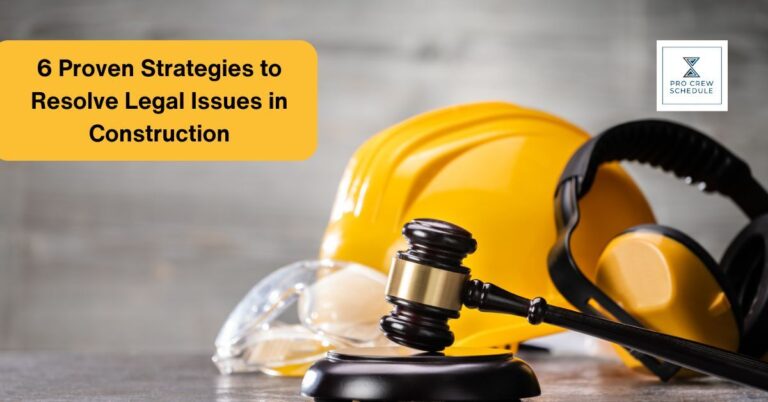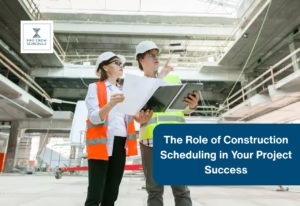Around the globe, the construction industry is regarded as one of the foundations of economic growth, infrastructure, and community development. However, construction is also regarded as one of the most complex and difficult industries. Besides technical issues, legal problems are a typical concern faced by construction developers, contractors, firms, and other stakeholders. In today’s article, we will dive deep into some of the most common legal problems in construction and explore effective ways to address them.
What are Legal Documents in Construction?
When engaging in construction projects, it is vital to understand the legal documents used in the industry operations. Common legal documents that professionals in construction must navigate include construction contracts, building codes, and land-use regulations. Here are their definitions in a nutshell:
- A contract is an agreement between two or more parties that usually sets out the specific rights and obligations of everyone involved.
- Building codes are government-mandated regulations that establish quality and safety standards in construction projects.
- Lastly, land-use regulations regulate the types of construction activities that can occur on particular property locations.
Knowledge of these construction documents is important to ensure that the activities laid out for your projects comply with the law.
What are Common Legal Issues in the Construction Industry?
Contract Disputes
Contract disputes are among the most prevalent and preventable legal problems in construction. Common contract issues arise from disagreements over your contract scope of work, terms and conditions, delays, payment issues, and many other factors. To mitigate this kind of dispute occurring, you must have comprehensive and well-drafter contracts that clearly outline the responsibilities, rights, and expectations of everyone involved in your construction project. Engaging with attorneys with expertise in construction disputes to draft and review your contracts can considerably reduce the likelihood of issues and protect the interests of all parties.
Afterward, you can store your contracts in construction crew management software with a document management feature so you can pull out any needed document when disputes arise and protect your team and your company.
Payment and Billing Concerns
Payment issues are infamous in the construction industry, with withheld or delayed payments causing major financial strain for contractors, subcontractors, and even suppliers. These problems often occur due to unclear payment schedules per milestone, unexpected change orders, or poor workmanship of workers. Implementing payment terms, adhering to them very strictly, and having proper documentation for any changes can help reduce your payment-related conflicts. It is also important that you understand the mechanic’s lien laws in your particular jurisdiction, as they provide you protection against non-payment to contractors, subcontractors, and suppliers.
Delays and Time Extensions
Construction projects typically experience delays for various reasons, such as labor shortages, material delays, design changes, inclement weather, and unforeseen site conditions. These delays can lead to contractual disputes and cost overruns. Proper management, documentation of delays, and a proper material schedule are vital to avoid legal complications in the long run. When faced with potential delays in your project, it is critical to notify everyone involved promptly, seek time extensions as needed, and maintain a clear record of all communications.
Workplace Safety and Liability
Construction sites are naturally hazardous environments, and accidents are a serious concern. Workplace injuries not only harm on-site workers but also expose firms to potential regulatory fines and lawsuits. Providing proper training to workers, maintaining a safe working environment, and making sure that compliance with safety regulations are essential steps to minimize liability and prevent accidents. Additionally, carrying appropriate insurance coverage can protect companies in the event of unforeseen accidents that can have legal consequences.
Design Issues and Defects
Design errors and construction defects can lead to delays, costly rework, and potential legal claims. This is why collaborative efforts between engineers, architects, and contractors during the phase, with the help of crew planning software, can help identify and handle potential issues early on. Additionally, implementing quality control measures and regular inspections throughout all the construction phases can prevent design-related problems from arising when it’s too late.
Environmental and Regulatory Compliance
Strict compliance with environmental regulations is a developing concern in the construction industry. Not complying with these regulations can result in project delays, fines and penalties, and damage to a company’s reputation. This is why construction firms should proactively identify and settle potential environmental issues related to their projects, acquire necessary permits, and implement sustainable methodologies wherever possible. Consulting with environmental experts and attorneys can help you navigate the complexities of environmental compliance in the construction industry.
Disputes with Suppliers and Subcontractors
Construction projects usually involve multiple suppliers and subcontractors, each with their obligations and interests. Disputes may arise concerning material quality, payments, delays, or defective work. Selecting reputable subcontractors, promoting open communication, having a proper construction crew scheduling, and resolving disagreements through alternative dispute resolution mechanisms, like mediation or arbitration, can prevent disputes from getting worse and avoid costly litigation.
What are Strategies to Resolve Legal Disputes in a Construction Project?
Construction projects can become complicated if not managed properly. A disagreement can be time-consuming and costly for all the project stakeholders involved. Whether the supplier or the contractor needs legal assistance, it is vital to understand how these issues arise and what can be done to settle them peacefully.
1. Negotiation
Negotiation is always the first dispute resolution method that comes to mind, and it is also used extensively in the construction industry. Here, the party or their representative attempts to reach an agreement without the involvement of any third party. The meetings are usually private, and agendas are often confidential.
In a construction project, negotiation is often the first step in resolving disputes among the stakeholders. It avoids an uncompromising attitude and focuses on finding a halfway solution that pleases both parties. Typically, the success of any negotiation hinges on the quality of the stakeholders’ communications with one another.
2. Mediation
A mediator facilitates conflict resolution. The mediator is an impartial third party who helps the disputing parties reach a resolution.
Other names for mediation include “brokered negotiation” and “assisted discussions.”
Unlike litigation and arbitration, mediation only facilitates communication between the parties directly involved in the conflict. It does not provide a final verdict or make any decision for the involved parties.
The terms of the agreement are decided solely by the mediated parties. There is no legal right or wrong verdict involved in the process.
3. Conciliation
Conciliation is frequently compared to mediation. In contrast to mediation, which takes place in secret between the mediator and the parties involved, in this instance, an impartial third party facilitates the settlement in front of both parties.
In conciliation, shuttle diplomacy is used when an impartial third person hears both sides’ points of contention. The conciliator makes a written resolution proposal based on the proceedings. After that, it is up to the parties to decide whether or not to accept the suggested resolution. The parties are under no obligation to follow the decision.
If the dispute moves to arbitration, the conciliator cannot be appointed as an arbitrator unless both parties agree in writing.
4. Arbitration
In arbitration, the clashing parties agree to turn over the dispute to one or more arbitrators. It is usually called “privatized litigation” since the proceedings and final verdict are outside the domain of the legally binding and imposing judicial jurisdiction. However, the parties involved in the conflict are bound to comply with the outcome of the arbitration procedure since they mutually select the arbitrator.
It may be vital to observe that arbitration, like litigation, centers on the parties” legal rights, and an arbitral proceeding is, on some occasions, not much different from a court proceeding. Yet, unlike litigation, where everything is open to the public, arbitration maintains the secrecy and privacy of the matter. The parties who are not involved in the proceedings are not allowed.
5. Adjudication
Adjudication is very similar to arbitration, except that it is legally binding. Unlike arbitration, which is private in resolving disputes, adjudication is public, and decisions are taken by a panel of judges or a judge who acts as the adjudicator. Adjudication is governed by a country’s formal acts and rulings, requiring more solid and formal evidence and a rule-based process of doing things.
6. Litigation
Lastly, litigation is an aggressive way of settling disputes that focuses on legal rights in carrying out proceedings. This is because of the adversarial nature of the litigation process, where one party confronts another party using the formal rules and laws implemented in the jurisdictional area.
However, litigation as the final choice for dispute resolution has decreased in past years due to the length of time it takes to settle disputes or reach a final verdict. Instead, litigation is being used to support and supervise other dispute resolution mechanisms or to enforce their results. This would help to implement other dispute resolution methods efficiently, especially in the construction industry.
Key Takeaway
The construction industry, while challenging and rewarding, is not without its legal difficulties. Contract disputes, delays, workplace safety, payment issues, design errors, environmental compliance, and disputes with subcontractors are just a few of the common problems that construction stakeholders may face.
To navigate these legal challenges successfully, construction companies must prioritize clear communication and proper documentation management. Pro Crew Schedule, a construction crew management software, can help your company keep track of your schedule commitments, maintain connection with your stakeholders, and provide a reliable platform for the safekeeping of your documents. This way, legal issues can be prevented, and you can have peace of mind that no disputes may arise.







